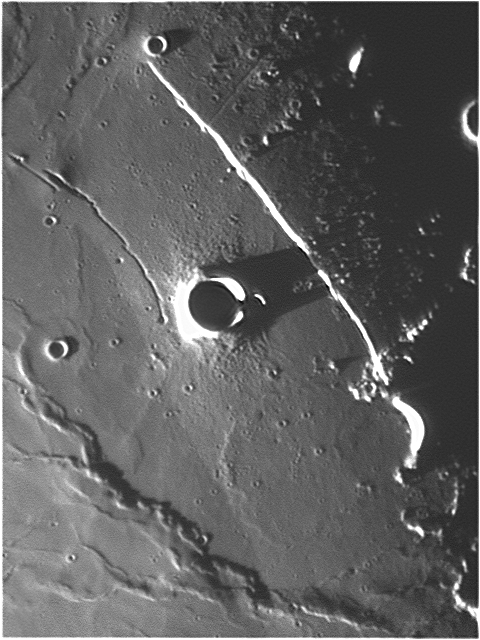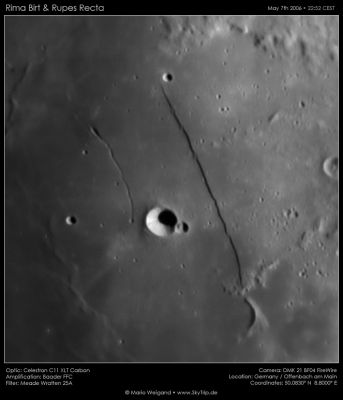Difference between revisions of "Rupes Recta"
| Line 6: | Line 6: | ||
Lat: 22.1°S, Long: 7.8°W, Length: 134 km, Height: 0.49 km, [http://the-moon.us/wiki/R%C3%BCkl%2054 Rükl 54]<br /> | Lat: 22.1°S, Long: 7.8°W, Length: 134 km, Height: 0.49 km, [http://the-moon.us/wiki/R%C3%BCkl%2054 Rükl 54]<br /> | ||
|} | |} | ||
| − | [http://higginsandsons.com/astro/images/NEW_Rupes_Recta_A47S297_11-05-04_P5IP1ROTATE.jpg [[Image:NEW_Rupes_Recta_A47S297_11-05-04_P5IP1ROTATE.jpg|external image NEW_Rupes_Recta_A47S297_11-05-04_P5IP1ROTATE.jpg]]] [http://www.lpod.org/coppermine/displayimage.php?pid=570&fullsize=1 [[Image: | + | [http://higginsandsons.com/astro/images/NEW_Rupes_Recta_A47S297_11-05-04_P5IP1ROTATE.jpg [[Image:NEW_Rupes_Recta_A47S297_11-05-04_P5IP1ROTATE.jpg|external image NEW_Rupes_Recta_A47S297_11-05-04_P5IP1ROTATE.jpg]]] [http://www.lpod.org/coppermine/displayimage.php?pid=570&fullsize=1 [[Image:Normal_rupes2006-05-07a.jpg|external image normal_rupes2006-05-07a.jpg]]]<br /> Left: [http://higginsandsons.com/astro/images/NEW_Rupes_Recta_A47S297_11-05-04_P5IP1ROTATE.jpg Wes Higgins], Right: [http://lpod.org/coppermine/displayimage.php?pos=-570 Mario Weigand]<br /> These two telescopic photographs of '''Rupes Recta''' (the '''Straight Wall'''), the bowl-shaped crater '''Birt''', and the '''''Stag's Horn Mountains''''' (the system of bay-shaped crater remains at the southern end of the '''Straight Wall''') were made during two different moments in a lunar day (pre-sunset circumstances in the photograph at left, morning circumstances in the photograph at right).<br /> <br /> <div id="toc"> |
==Images== | ==Images== | ||
| Line 20: | Line 20: | ||
<br /> | <br /> | ||
==Description: Elger== | ==Description: Elger== | ||
| − | ''([http://the-moon.us/wiki/IAU% | + | ''([http://the-moon.us/wiki/IAU%20directions IAU Directions])'' THE STRAIGHT WALL.--Sometimes called "the railroad," is a remarkable and almost unique formation on the E. side of [http://the-moon.us/wiki/Birt Birt], extending for about 65 miles from N.W. to S.E. in a nearly straight line, terminating on the south at a very peculiar mountain group, the shape of which has been compared to a [http://the-moon.us/wiki/Stag%27s%20Horn%20Mountains stag's horn], but which perhaps more closely resembles a sword-handle,--the wall representing the blade. When examined under suitable conditions, the latter is seen to be slightly curved, the S. half bending to the east, and the remainder the opposite way. The formation is not a ridge, but is clearly due to a sudden change in the level of the surface, and thus has the outward characteristics of a "fault" Along the upper edge of this gigantic cliff (which, though measures differ, cannot be anywhere much less than 500 feet high) I have seen at different times many small craterlets and mounds. Near its N. end is a large crater, and on the E. is a row of hillocks, running at right angles to the cliff. No observer should fail to examine the wall under a setting sun when the nearly perpendicular W. face of the cliff is brilliantly illuminated.<br /> <br /> |
==Description: Wikipedia== | ==Description: Wikipedia== | ||
[http://en.wikipedia.org/wiki/Rupes_Recta Rupes Recta]<br /> <br /> | [http://en.wikipedia.org/wiki/Rupes_Recta Rupes Recta]<br /> <br /> | ||
==Additional Information== | ==Additional Information== | ||
| − | * Fault height data from [http://the-moon.us/wiki/Kurt%20Fisher% | + | * Fault height data from [http://the-moon.us/wiki/Kurt%20Fisher%20Crater%20Depths Kurt Fisher database] |
** Viscardy, 1985: 0.3 km | ** Viscardy, 1985: 0.3 km | ||
** Cherrington, 1969: 0.36 km | ** Cherrington, 1969: 0.36 km | ||
| Line 32: | Line 32: | ||
* Estimates of height and slope based on visual measurements with a 6-inch reflector were published by Ashbrook (1960). | * Estimates of height and slope based on visual measurements with a 6-inch reflector were published by Ashbrook (1960). | ||
| − | * Steve Boint measured the cast shadows and published height measurements from along the cliff in an article "[http://the-moon.us/wiki/Measuring%20Rupes%20Recta Measuring Rupes Recta]" in the Spring 2003 issue of ''Selenology: Journal of the American Lunar Society''. <span class="membersnap">- [http://www.wikispaces.com/user/view/fatastronomer [[Image: | + | * Steve Boint measured the cast shadows and published height measurements from along the cliff in an article "[http://the-moon.us/wiki/Measuring%20Rupes%20Recta Measuring Rupes Recta]" in the Spring 2003 issue of ''Selenology: Journal of the American Lunar Society''. <span class="membersnap">- [http://www.wikispaces.com/user/view/fatastronomer [[Image:Fatastronomer-lg.jpg|16px|fatastronomer]]] [http://www.wikispaces.com/user/view/fatastronomer fatastronomer]</span> |
| − | * Alexander Vandenbohede measured several photographs of this area and published detailed results including height and slope info along the length of the cliff on pages 3-9 of the [http://www.zone-vx.com/TLO200501.pdf Jan. 2005] issue of ''[http://www.zone-vx.com/tlo_back.html The Lunar Observer]''. <span class="membersnap">- [http://www.wikispaces.com/user/view/fatastronomer [[Image: | + | * Alexander Vandenbohede measured several photographs of this area and published detailed results including height and slope info along the length of the cliff on pages 3-9 of the [http://www.zone-vx.com/TLO200501.pdf Jan. 2005] issue of ''[http://www.zone-vx.com/tlo_back.html The Lunar Observer]''. <span class="membersnap">- [http://www.wikispaces.com/user/view/fatastronomer [[Image:Fatastronomer-lg.jpg|16px|fatastronomer]]] [http://www.wikispaces.com/user/view/fatastronomer fatastronomer]</span> |
| − | * Boint measured and plotted a profile of the Straight Wall on page 10 of the [http://www.zone-vx.com/TLO200805.pdf May 2008] issue of [http://www.zone-vx.com/tlo_back.html The Lunar Observer]. <span class="membersnap">- [http://www.wikispaces.com/user/view/fatastronomer [[Image: | + | * Boint measured and plotted a profile of the Straight Wall on page 10 of the [http://www.zone-vx.com/TLO200805.pdf May 2008] issue of [http://www.zone-vx.com/tlo_back.html The Lunar Observer]. <span class="membersnap">- [http://www.wikispaces.com/user/view/fatastronomer [[Image:Fatastronomer-lg.jpg|16px|fatastronomer]]] [http://www.wikispaces.com/user/view/fatastronomer fatastronomer]</span> |
| − | * R. Lena, C. Wohler, and M.T. Bregante published a very detailed study of Rupes Recta and the adjacent area on pages 41-66 in [http://digidownload.libero.it/glrgroup/selenologytoday10.pdf volume 10] of Selenology Today. <span class="membersnap">- [http://www.wikispaces.com/user/view/fatastronomer [[Image: | + | * R. Lena, C. Wohler, and M.T. Bregante published a very detailed study of Rupes Recta and the adjacent area on pages 41-66 in [http://digidownload.libero.it/glrgroup/selenologytoday10.pdf volume 10] of Selenology Today. <span class="membersnap">- [http://www.wikispaces.com/user/view/fatastronomer [[Image:Fatastronomer-lg.jpg|16px|fatastronomer]]] [http://www.wikispaces.com/user/view/fatastronomer fatastronomer]</span> |
* Additional rille at the eastern side of the northern section of '''Rupes Recta:''' http://bit.ly/2AoFt05 (this very shallow rille was also captured on the telescopic photographs of '''Birt''' and '''Rupes Recta''' at the top of this page) (it seems that this rille really shows up during local pre'''-'''sunset conditions). | * Additional rille at the eastern side of the northern section of '''Rupes Recta:''' http://bit.ly/2AoFt05 (this very shallow rille was also captured on the telescopic photographs of '''Birt''' and '''Rupes Recta''' at the top of this page) (it seems that this rille really shows up during local pre'''-'''sunset conditions). | ||
<br /> | <br /> | ||
Revision as of 02:13, 16 April 2018
The Straight Wall - and the Stag's Horn Mountains
(original IAU name; current IAU name = Rupes Recta)
|
Lat: 22.1°S, Long: 7.8°W, Length: 134 km, Height: 0.49 km, Rükl 54 |


Left: Wes Higgins, Right: Mario Weigand
These two telescopic photographs of Rupes Recta (the Straight Wall), the bowl-shaped crater Birt, and the Stag's Horn Mountains (the system of bay-shaped crater remains at the southern end of the Straight Wall) were made during two different moments in a lunar day (pre-sunset circumstances in the photograph at left, morning circumstances in the photograph at right).
Images
LPOD Photo Gallery Lunar Orbiter Images Apollo ImagesKaguya HDTV
- Apollo 16's Fairchild Mapping/Metric camera aboard CSM Casper's SIM-bay captured extraordinary oblique southward looking photographs which show the shadowed part of Rupes Recta during local morning light. Two of those photographs, AS16-M-2484 and 2485 could be used as a 3D-STEREO image, to show a most exquisite bass-relief effect! Research Danny Caes.
- Kaguya Image - big but impressive.
Paintings and drawings of the straight wall (Rupes Recta)
Most pre-spaceflight paintings and drawings of Rupes Recta show it as being a huge "wall"; almost looking like a huge tsunami made of petrified lunar magma. In Willy Ley's book The Conquest of Space (1951) there's such a painting made by Chesley Bonestell (Plate XXI between pages 38 and 39 in the Dutch translation De Sprong in het Heelal, 1951). - DannyCaes Apr 15, 2012
Maps
(LAC zone 95A4) LAC map Geologic map
Description
Description: Elger
(IAU Directions) THE STRAIGHT WALL.--Sometimes called "the railroad," is a remarkable and almost unique formation on the E. side of Birt, extending for about 65 miles from N.W. to S.E. in a nearly straight line, terminating on the south at a very peculiar mountain group, the shape of which has been compared to a stag's horn, but which perhaps more closely resembles a sword-handle,--the wall representing the blade. When examined under suitable conditions, the latter is seen to be slightly curved, the S. half bending to the east, and the remainder the opposite way. The formation is not a ridge, but is clearly due to a sudden change in the level of the surface, and thus has the outward characteristics of a "fault" Along the upper edge of this gigantic cliff (which, though measures differ, cannot be anywhere much less than 500 feet high) I have seen at different times many small craterlets and mounds. Near its N. end is a large crater, and on the E. is a row of hillocks, running at right angles to the cliff. No observer should fail to examine the wall under a setting sun when the nearly perpendicular W. face of the cliff is brilliantly illuminated.
Description: Wikipedia
Additional Information
- Fault height data from Kurt Fisher database
- Viscardy, 1985: 0.3 km
- Cherrington, 1969: 0.36 km
- R. Lena, C. Wohler, and M.T. Bregante, 2008: 0.49 km max, 21° slope max
- Estimates of height and slope based on visual measurements with a 6-inch reflector were published by Ashbrook (1960).
- Steve Boint measured the cast shadows and published height measurements from along the cliff in an article "Measuring Rupes Recta" in the Spring 2003 issue of Selenology: Journal of the American Lunar Society. - fatastronomer fatastronomer
- Alexander Vandenbohede measured several photographs of this area and published detailed results including height and slope info along the length of the cliff on pages 3-9 of the Jan. 2005 issue of The Lunar Observer. - fatastronomer fatastronomer
- Boint measured and plotted a profile of the Straight Wall on page 10 of the May 2008 issue of The Lunar Observer. - fatastronomer fatastronomer
- R. Lena, C. Wohler, and M.T. Bregante published a very detailed study of Rupes Recta and the adjacent area on pages 41-66 in volume 10 of Selenology Today. - fatastronomer fatastronomer
- Additional rille at the eastern side of the northern section of Rupes Recta: http://bit.ly/2AoFt05 (this very shallow rille was also captured on the telescopic photographs of Birt and Rupes Recta at the top of this page) (it seems that this rille really shows up during local pre-sunset conditions).
Charles A. Wood's Ancient Thebit
- Rupes Recta and the Stag's Horn Mountains are surrounded by the remains of an old impact basin, unofficially called Ancient Thebit by Charles A. Wood because crater Thebit is located on the eastern part of this basin's rim. Ancient Thebit is depicted on SLC map D6.
Nomenclature
- Latin for "straight cliff" (The straight wall).
- According to former Sky and Telescope editor Joseph Ashbrook, discovery of the Straight Wall is usually attributed to J. H. Schröter. But Ashbook noticed it had actually been seen and drawn by Christiaan Huygens, using a 123-foot (focal length) refractor on the nights of May 30-31, 1686. This fact was little known until the publication of Huygen’s Collected Works in 1925. - Jim Mosher
- Whitaker (p 229) reports that Birt is apparently the originator of the name "Straight Wall"; it was latinized in 1961.
- The nickname Railway (or Railroad), long used by British observers (including Elger), appeared on a moonmap which was included in the LPOD of February 11, 2004.
- As mentioned above, Rupes Recta runs through the centre of a large (more-or-less circle shaped) region which is unofficially called Ancient Thebit.
- The system of bay-shaped crater remains at the southern end of Rupes Recta is sometimes called the Stag's Horn Mountains.
LPOD Articles
Nokia Moon.
Righteous Recti
Obliquely Viewed Fault
More Discoveries Near the Straight Wall
Straight Wall
New Observations of a Well-Known Area
Cornucopia of Details
The Beetle (shadowed Rupes Recta, with nearby Birt looking like a "beetle").
Succession
Lunar 100
L15: Best example of a lunar fault.
Bibliography
- Ashbrook, J. 1965. The "long night" of selenography. Sky and Telescope, p. 92. Reprinted in The Astronomical Scrapbook (Cambridge University Press, 1984), Ch. 47.
- Ashbrook, J. 1960. The Lunar Straight Wall. Publications of the Astronomical Society of the Pacific. Vol. 72, pp. 55-58.
- Wood, C.A. 200?. Ancient Thebit and Huygens's Sword. Sky and Telescope Online Article. <>
- Wood, C.A. 8/2006. Lunar Half Craters. Sky and Telescope 112(2): 62-63.
- Wood, C.A. 12/2005. Exploring the Moon. Sky and Telescope110(6): 63-64.